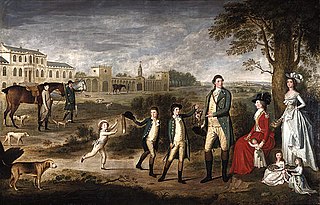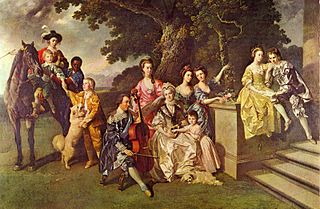
The Stewart baronetcy, (alternatively Stuart), [2] of Castlemilk in the County of Lanark, was created in the Baronetage of Nova Scotia on 29 February 1668 for Archibald Stewart. The title became extinct on the death of the fifth Baronet in 1797. [3]

The Stewart baronetcy, (alternatively Stuart), [2] of Castlemilk in the County of Lanark, was created in the Baronetage of Nova Scotia on 29 February 1668 for Archibald Stewart. The title became extinct on the death of the fifth Baronet in 1797. [3]
There have been five Dunbar Baronetcies; the first four in the Baronetage of Nova Scotia, and the last in the Baronetage of the United Kingdom. There is also a Hope-Dunbar Baronetcy of Baldoon.
There have been eleven Gordon Baronetcies :

There have been three baronetcies created for persons with the surname Croft, one in the Baronetage of England and two in the Baronetage of the United Kingdom. All three creations are extant as of 2008.
Nineteen baronetcies have been created for persons with the surname Hamilton, eight in the Baronetage of Nova Scotia, one in the Baronetage of England, five in the Baronetage of Ireland, one in the Baronetage of Great Britain and four in the Baronetage of the United Kingdom. As of 2008 two creations are extant, two are dormant, two are either extinct or dormant and twelve extinct.

There have been five baronetcies of the United Kingdom created for a person with the surname Erskine, two in the Baronetage of Nova Scotia, one in the Baronetage of Great Britain and two in the Baronetage of the United Kingdom. Two of the creations are extant as of 2010.
There have been five baronetcies created for people with the surname Napier, three in the Baronetage of England, one in the Baronetage of Nova Scotia and one in the Baronetage of the United Kingdom. As of 2014 two of the creations are extant.
There have been three baronetcies created for members of the Stonhouse family, all in the Baronetage of England. Two of the creations are extant as of 2021.
There have been five Baronetcies created for people with the surname Forbes, four in the Baronetage of Nova Scotia and one in the Baronetage of the United Kingdom. The first holder of the Burn Baronetcy of Jessfield, created in the Baronetage of the United Kingdom in 1923, assumed the surname of Forbes-Leith of Fyvie in 1925.

There have been five baronetcies created for persons with the surname Young, one in the Baronetage of England, one in the Baronetage of Great Britain and three in the Baronetage of the United Kingdom. As of 2014, four of the creations are extant.

There have been four baronetcies created for persons with the surname Hope, three in the Baronetage of Nova Scotia and one in the Baronetage of the United Kingdom. As of 2010 one creation is extant, one dormant and two extinct.

The Gibson, later Gibson-Carmichael, later Gibson-Craig-Carmichael Baronetcy, of Keirhill in the County of Edinburgh, is a title in the Baronetage of Nova Scotia. It was created on 31 December 1702 for Thomas Gibson, with remainder to his heirs male. The sixth Baronet assumed the additional surname of Carmichael. The eleventh Baronet was a Liberal politician. In 1912, he created Baron Carmichael, of Skirling in the County of Peebles, in the Peerage of the United Kingdom. The barony died in 1926, while he was succeeded in the baronetcy by his kinsman Sir Henry Thomas Gibson-Craig-Carmichael, 5th Baronet, of Riccarton, who became the twelfth Baronet of Keirhill and assumed the additional surname of Carmichael.
Six baronetcies have been held by the Grant family.

There have been three baronetcies created for members of the Sedley family of Kent, all in the Baronetage of England. All three creations are extinct.
Wigtownshire was a constituency represented in the Parliament of Scotland until 1707.
The title of Baronet of Blair and Balcaskie in the county of Fife, was created on 2 June 1683 in the Baronetage of Nova Scotia for Thomas Stewart of Balcaskie, a Lord of Session. He was son of Henry Stewart and grandson of Sir William Stewart, 11th of Grantully and Murthly, both in Perthshire. 1st of Grantully was Sir John Stewart, Lord of Lorne, great-great-grandson of Alexander Stewart, 4th High Steward of Scotland. Murthly had been acquired by the family in 1615.
Three Steuart baronetcies were given to three brothers, the first, fourth, and seventh of the seven sons of Sir James Steuart, knight, Lord Provost of Edinburgh, who died in 1681.
Sir Robert Steuart, 1st Baronet of Allanbank was a Scottish politician who represented North Berwick in the Parliament of Scotland from 1698 to 1702.
Andrew Stuart was a Scottish lawyer and politician who sat in the House of Commons between 1774 and 1801.
There have been three baronetcies created for people with the surname Moncreiffe or Moncreiff, two in the Baronetage of Nova Scotia and one in the Baronetage of the United Kingdom. Two of the titles are dormant, as the heir has not proved his descent, and one is extant, though its holder does not bear the surname of Moncreiffe.
Before the Acts of Union 1707, the barons of the shire of Renfrew elected commissioners to represent them in the unicameral Parliament of Scotland and in the Convention of the Estates. The number of commissioners was increased from two to three in 1690.